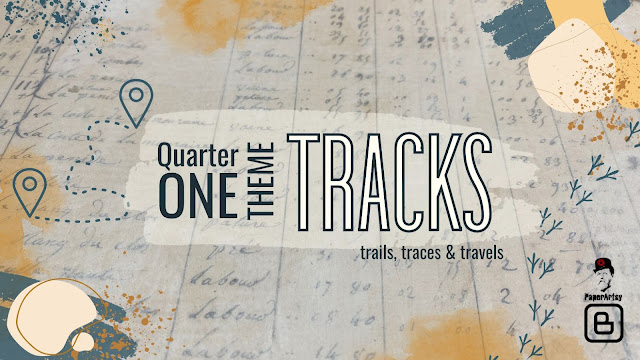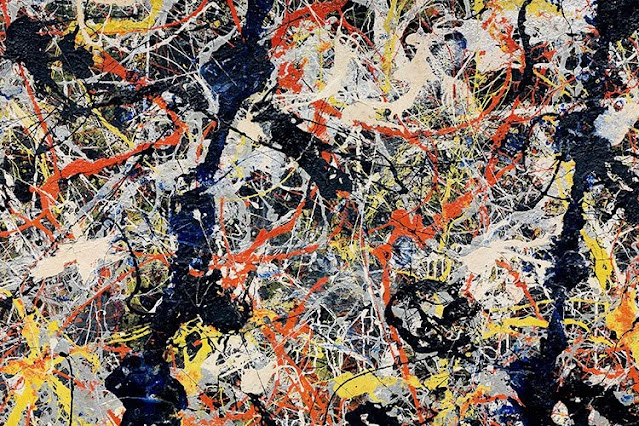Hello, Dounia here to present a new feature on the blog for 2023: quarterly themes! And as you can see our first theme is TRACKS.
We will still have monthly changing Topics as usual; a mix of projects, colour and designer focus. However, to mix things up a bit, we are introducing an overarching theme to span 3 topics. These themes are keep purposefully very open, so they are compatible with all manner of projects and styles. The theme will be incorporated, along with the topic, by each of our bloggers in their posts. This will be an underlying 'red thread' adding an extra layer! It is a new tool for us (and you) to guide our process and spark inspiration. Hopefully this will create new unexpected combinations and inventive solutions! We can't wait to see what you make of it! Here is a glimpse of the year we have planned for the PA Blog.
For this first quarter, our theme is : TRACKS. It evokes a lot of different ideas that we will explore in this post, but as a first taste, here is the word cloud our bloggers were given for insipration.
This theme will apply across the 3 topics of the quarter (Shrines, Tetradic colours, and Seth Apter) and our original idea when choosing this theme was mark-making, as we recognise this is a big part of Seth's art, but also has been a strong trend in the mixed media community for a number of years, so it was a good fit for Quarter One.
Tracks are present in all form of recorded art from the beginning of records, even cave paintings and portable Palaeolithic art. The Cosquer Cave, for example, is know for its hand stencils dating from 27000 BP (as well as its underwater entrance, and paintings of penguins!).
Sipa /Patrick Aventurier
Mark-making is a personal way of recording touch, and leaving a trace of oneself. One of its truest and timeless expressions is graffiti, found from the ruins of Pompei to our modern cities! It continues on our journal pages, when writing also becomes a pattern.
Ofir Abramovich
Many modern and contemporary artists have made mark-making the centre of their practice. Exploring the contrast between precise imagery and hand drawn signs can create your own symbolism, in the movement of Richard Texier:
Inspired by Jackson Pollock, movement, and the marks it leaves, can become your expression - mixing planning and happy accidents. For more artistic inspiration, you can follow this simple and beautifully illustrated Mark Making course by the Tate Museum.
Mark-making is becoming more and more prevalent in mixed media ant journaling as it is easy, fun and intuitive, as explained in this Quick Guide by InStitches. It consequently is a recurring topic on the PaperArtsy blog:
In project, marks can fill the page, be the focus, do most of the talking, creating layers between themselves using colour and values. Here is a useful video on How to use mark making to create tone by The art of teaching art.
Roxanne Coble
However, they can also be more discrete and form a complex and significant background for a different main focal.
Mark-making is also a great occasion to invent and explore new tools, to better reflect your own touch and feelings. Check for example this video on Mark Making with homemade brushes by Michiardi Alexandra.
For some more inspiration, here is An exploration of Mark Making, including textiles, in four parts by Maria Walker. You can also enjoy some eye-candy and maybe start you creative process thanks to this Pinterest Collection by Blandine Campion
Tracks as a theme also evokes movement and travel: rail road tracks, mysterious tracks in the snow, the mud or the forest, or machine tracks over wood or stone. A great representation of those are maps and plans. Already full of their own colours, writings and symbols, they are a marvellous material, ready to be revealed.
Maps are instantly recognisable, making them great elements in a composition, bringing meaning at a glance. We already featured them on the PaperArtsy blog:
2019 Topic 05: Maps and Plans
Their texture is also a fabulous background, to strategically peak through the top layers. You can imagine in their outlines your own paint by number project!
Maps were originally very precious and expensive resources. They were made to be informative and striking and often embellished and illustrated.
This is a great idea to celebrate your travels or places of meaning, adding significant vignettes and writing to illustrate your journey and feelings. Emily Ref explains how in these often difficult times Maps provide a sense of direction in artistic creation.
But maps are not limited to real places! Why not make up you own planet, country or town? You can then create your own symbols and colour coding for an imaginary journey.
And let's not stop at physical places! Like the Map of Tendre illustrating the path to love, can chart the road to success, serenity or creativity!
To see more map inspiration, in a lot of different styles, go check these Artistic Street Maps collected by Guide to Camden (the whole blog is about creating an interactive map).
From tracks, paths and roads, then we logically follow them on a journey! Travel journals, written and illustrated, have been around since we first learned how to travel.
If recording your days is already a mindful practice, preserving the memory of your adventures, making them in preparation of a trip or vacation is a step further in creating a personal and beautiful object.
Travels are not the only journeys you can keep track of... Before going anywhere, you had to get here! A family tree maps your careful path to life, from relative to relative through the generations.
If family trees were once the main way to record the main events of the generations, nowadays they are also a way to remember where we come from. You could broaden the concept to include the lore and beliefs of your homeland for example.

After keeping track of the past, let's focus on the present. Diaries are certainly nothing new, even ones involving art, as illustrated by this video about 5 Famous Visual Diaries by Lilian Gray. They are however coming back into our busy modern life in the form of planner and bullet journals.
They are a great way to record and celebrate day to day life, helping us be more present in our lives for better balance. For more inspiration, here is beautifully curated Bullet Journal collection by Randy Hylton.
While mood trackers are common in journal, the temperature blanket, a project tracking the weather during a year, is taking the crochet world by storm. What other every day data could you colourfully follow? Perhaps this concept could work in a paper journal too?
Freeing itself of the day to day aspect, Art Journaling is one of the main artistic practises nowadays, mixing creativity and self reflection. If you are interested, check How to start an art journal step by step by artjournalist. The possibilities are infinite, get a taste thanks to Trish W's The Art of Journaling Collection. We also have many examples on the blog, including:
In this section, I focus on an abstract interpretation of 'Tracks'. For example, following in somebody's tracks. We are not creating in a vacuum. Many great works of art are part of our creative framework. We can certainly have fun with them, like the dozens of quarantined people who have re-created famous scenes using household items.
They are so full of imagination! To enjoy more of them, go here and here also! You can also check this humorous Appropriation Art collection by Agnes Kwok.
A great identifier of an artist or artistic movement is of course style. Have you ever wondered what different subjects would look like painted by Picasso, Van Gogh or Monet? Well, wonder no more!
These images are computer generated and you can enjoy more of them exploring Style Transfer. Being inspired and influenced by other creators is a natural part of artistic practice. As long we are honest and transformative about it, it can also often be an essential part of our development as makers.
Centered more around illustration, this NY Times lesson is a great concept Exploring the creative process by Amy Charleroy, touching on researching, references and experimenting with materials.
Lots of us also want to find our own way. Make pieces that are 'us', create our own track. Let's remember that it takes time and practice and that one's style generally evolves during their creative life. Sure, Picasso is an extreme example but this series of self-portraits is quite telling!
Maybe Ten steps to creating original art by Deborah Wirsu can help you start, or improve, personalising your creations. But do not forget:
Another interesting practice is Revisiting and Transforming your Art by Carolyn Mehlomakulu, which helps you keep track of your progress and evolution. Facing old projects is not always easy so:
Finally, some of our bloggers already embarked on this journey, so they might inspire or comfort you with their own tribulations and experimentations in:
I hope this has given you plenty of food for thought as to a range of ways we can interpret this theme TRACKS. As our bloggers create over the coming 3 months, their posts will touch on this theme alongside the posts they create specific to each topic.
Perhaps you might like to join us over in our friendly Facebook community 'PaperArtsy People' to see what others are up to with their PaperArtsy products, and maybe also using the content we share on the blog as inspiration.



















.jpg)










Oh this is very exciting. Thanks, I really enjoyed reading all about it.
ReplyDeleteReally liking the sound of the quarterly themes and looking forward to participating :)
ReplyDeleteThanks for sharing all the inspiration / great ideas of ways the theme could be interpreted , Dounia.
Thoroughly enjoyed reading .
A x